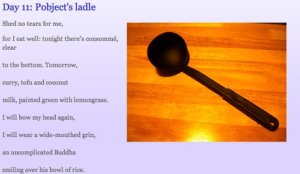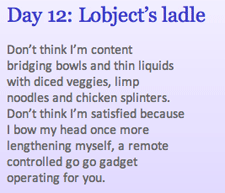Object(ive) Writing: A Creative Exercise for the Composition Classroom
At the 2012 Conference on College Composition and Communication, three well-known writing scholars led a discussion on a writing exercise they'd assigned themselves. For 30 days, each wrote for an hour about a different everyday object. After CCCC, three of us -- all friends, teachers and writers -- were energized by the idea of this activity and decided to try it out.
Our Rules
On each day for one month, each of us wrote for 30 minutes on one of the 30 objects we chose in advance -- each of us had selected 10. We could write about any object in any order and posted our writing on a public, communal blog.
We didn't confine ourselves to any particular writing process or genre. Moreover, we didn't erect boundaries between the objects' stories, so that, for instance, Laura's ladle spoke in defiant response to Patrick's (below).


The exercise proved to be powerful, helping us to engage one another in writing as we learned about each other, ourselves and the objects with which we interact every day. Midway through the exercise, we recognized its strong educational potential. Suitable for employment in any disciplinary context and at any level, this exercise encourages meaningful reflection as authors of our own work in the world and as an interacting community of coauthors.
Reflections
All three of us agreed to reflect on his or her experience during the process and to contribute to a final reflection blog. Below we have written some of the themes that emerged.
- It could make us feel a little vulnerable to put our writing "out there," but the rewards can be great.
- We discovered new things about ourselves and our writing processes that may have been left unexplored otherwise.
- We are never 100% satisfied with our written products, so why not go ahead and share? The process doesn't have to stop just because you shared work with others.
- What is writing? If we use a piece of writing that we worked on last year but we want to revise for a new project, is that "writing" or "cheating"? If we research aspects of an object, is that "writing time"? Is writing just getting words on paper or on a screen, or is it much more than that? With the constrained writing aspect of this project, we found ourselves reconsidering what a writing process may really consist of.
- Inspiration is everywhere. All we have to do is pay attention.
If we believe William Carlos Willams' famous dictum, "No ideas but in things!", the power of these kinds of composing activities seems obvious. We have a tendency to tokenize, to signify and to create connections. We are meaning-making machines, we human beings. Every thing around us means something, and if that meaning doesn't manifest itself of its own accord, we find meaning where meaning may not at first be. That meaning, in turn, says more about us than we might at first suspect, and that's where much of the educative power of this exercise lies.
We feel that educational value can be found also in both the freedom of an object and the unique experiences an author brings to the object. This object gives permission to reflect and imagine, yet also takes the blame if, once on the page, the words don't seem to work. The exercise genuinely invites low-stakes, no-pressure, anything-goes writing.
"That's ultimately what's struck me most about this project: how quickly I came to know my friends more deeply through their own words . . . I've known Kerri for some time now, and I found I learned just as much about her through 3 x 30 = 90 as I did about Laura." - Patrick
"I didn't always like the final product, but I needed the wouldn't-this-be-cool adventure to propel my summer writing. I've already begun revising and reworking. Although the 30-day writing exercise is officially over, I feel like I'm just getting started." - Laura
"I became much more aware and mindful of the objects and everything else that surrounds me. And my mind would start creating stories about them without even thinking about it." - Kerri
Writing as Praxis
The National Commission on Writing's The Neglected "R" (2003) defines writing as "an essential skill for the many" (p. 11) that "has helped transform the world" (p. 10). It also points out that writing is "increasingly shortchanged throughout school and college years" (p. 3). A simple truth is that we do not always teach writing in a way that allows students to experience its transformative power. Often we do not provide enough opportunities to experience writing as a vehicle for making sense of themselves and the world around them. As a result, writing is not always viewed as a practice. Rather, in some classrooms, it is procedure or product. Robert Yagelski (2012) asks what would happen if we dared to view writing as something other than a practice, procedure or product? “What if we understood writing as praxis?” (p. 189)
To consider writing as praxis is to consider what happens as we write, an act equally important for students and writing instructors. Peter Elbow (1973) points out that if we lack control over our words, we lack control over our lives. And while we do not exist because of writing, writing can bring our existence more sharply into focus. Inherently, writing is an act of connecting.
Objects in Composition Classrooms
So how can we use object writing in our classrooms? The flexibility of it makes the options almost limitless. With our students, we can decide the parameters and the desired product, whether that product is a blog, a multi-genre presentation or some other piece of low-stakes writing. The process and final product can be adapted to fit our classrooms and our students. Here are a few concrete ideas and suggestions:
- Select a material object, or an image depicting such an object, and write about it for a fixed amount of time. (Students may write for as little as five minutes, or as long as half an hour.) Write freely about the object, perhaps describing its nature, reflecting on your relationship to it, and uncovering connections between it and its surroundings.
- Use object writing as a "first-day" activity to break the ice and help students learn more about one another. Or, more broadly, use the activity as a rapport-building exercise at any point in a class, helping students to build the mutual trust and understanding that leads to a healthy learning community.
- Provide an authentic audience other than the self and the instructor. Whether the students write on a communal blog or take advantage of an "author's chair," it is essential to design some kind of platform for students to share their work.
- Students will get the most out of the activity if they are encouraged to reflect on their work. Try to allow as much reflection is possible, through discussion in class or through reflective writing after.
- Remember that students can be very averse to risk-taking, so encourage them to take some. If, for example, you plan on grading the activity, involve students in constructing the rubric you will use to assess their finished work.
Patrick Bahls and Laura Benton also contributed to this blog post.
